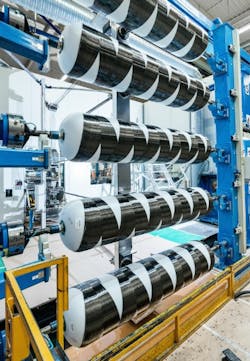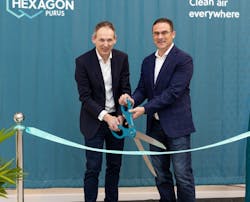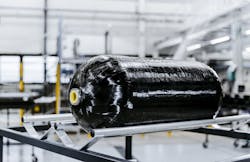H2 to the Future: Hexagon Purus banks on Fuel Cell Transport future with new Cylinder plant
WESTMINSTER, Maryland –If the transportation industry ever truly and fully decarbonizes, vehicle experts say the drive away from gasoline and diesel engines will arrive at one of two destinations.
Cars will become primarily electric, a vision made clearer with the EV moves announced by automakers such as GM, Ford, Toyota, Nissan and, yes, Tesla. Light-duty vans and trucks, such as last-mile delivery vans, also are highly likely to hold a battery at the heart of their power.For heavy-duty, long-range truck and buses planning long distance journeys, however, there isn’t a battery yet with long enough range and short enough charging time to make it economical or convenient.
The alternative there is fuel cells turning carbon-free hydrogen into electricity. And more and more companies are realizing that.
“We are on the move,” Morten Holum, CEO of hydrogen solution provider Hexagon Purus, said during the grand opening of his company’s new hydrogen cylinder manufacturing & assembly line in Westminster, Maryland late last week.
The $7 million investment in the Westminster plant could have Hexagon Purus on target to produce up to 10,000 cylinders annually for long-mile transport vehicles such as Class 8 tractors and large transit buses. The transportation sector in U.S. currently emits about 20-plus percent of the greenhouse gases released nationally.
“This is a proud and exciting moment for everybody in Hexagon Purus,” said the CEO of the Norwegian energy components firm. “This is the energy transition. This is our purpose. This is our reason for being.”
And it’s the reason the Westminster plant and its employees could get very busy shortly. Hexagon Purus makes a variety of hydrogen-capable cylinders which serve as the fuel tanks for carbon-free vehicles, and contracts are done or moving toward completion with such vehicle firms as Nickola, Hino and New Flyer.
Hydrogen is the smallest molecule and lightest gas on earth. It contains no carbon in its molecular makeup, has a relatively high energy density, and can be produced via electrolysis or steam reforming of methane gas.
The move to Westminster, Hexagon Purus leaders hope, is just a start to ramping up hydrogen tank capacity throughout North America, Europe and Asia, company executive vice president Michael Kleschinski said at the grand opening.
The Hexagon Group, parent company of Hexagon Purus, is engaged on several fronts of the battle to decarbonize the transportation sector, and has offered compressed natural gas tanks on the market for quite a long time. The addition of hydrogen, especially in the wake of H2-oriented shifts by companies such as Cummins and Caterpillar, made tremendous sense so Hexagon adapted its manufacturing plans to do that and spun off Hexagon Purus in 2020 as a separately listed company.
“Companies in trucking want hydrogen because it can go long distances and has quick refueling, compared with battery electric,” Kleschinski pointed out.
Hexagon Purus does not produce hydrogen nor even fill those tanks. What will happen in Westminster starting next week is an exacting manufacturing process involve winding of carbon fiber composite, resin, curing and pressure testing to ensure the H2 cylinder can contain its payload at compression measuring 350 to 700 Bar (or 5,000 to 10,000 PSI).
The company previously produced its cylinders in Maryland at three facilities in nearby Taneytown. Conewago Enterprises built the 60,000-square-foot facility purely on specs to draw Hexagon Purus to the complex.
Hexagon Purus CEO Holum is confident his company’s H2 customer base will continue to grow.
“We have lots of things going on with OEMs (original equipment manufacturers),” he said. “Lots of things in the industry are going on behind closed doors.”
Holum says a lot right there without saying too much. What isn’t so private are the location of Type 4 composite cylinders ready to be made and installed on buses by New Flyer and carbon-free semis made by Nikola. Demand could grow multi-fold in only a few years, with some financial forecasts predicting a $30 billion market by 2030.
The Hexagon Purus grand opening in Westminster also was attended by members of the U.S. Department of Energy, as well as Maryland’s state energy office and local and county officials.
“Everything you’re doing here is helping all of us achieve our missions,” Sunita Satyapal, director of DOE’s Hydrogen and Fuel Cell Technologies Office within the Office of Energy Efficiency and Renewable Energy, pointed out to the Hexagon Purus crew during her remarks at the grand opening.
Indeed, the U.S. government has earmarked about $9.5 billion toward helping incentivize development of H2 transportation infrastructure and equipment. The Biden Administration has touted a goal of producing 50 million metric tons of hydrogen annually.
Storing that light gas isn’t easy, and so Hexagon Purus puts its cylinder manufacturing through a demanding process. The company’s quality specs are tight enough that some of its tanks are used in the aerospace industry, where commercial launch vehicles need hydrogen and helium, the two lightest gases known to man.
And, of course, the availability of hydrogen fueling stations is always a little on the light side, as in few and far in-between. Although it’s the same with EV charging stations, all these companies leaning into a transportation energy transition point to the past as prologue.
“It’s a whole new ecosystem,” CEO Holum said. “Gasoline stations didn’t pop up overnight. We need to think decades ahead; this industry will grow for decades.”
The operational start of the Westminster H2 cylinder plant this week will allow some transportation sector customers to begin thinking about the here and now.
About the Author
Rod Walton, EnergyTech Managing Editor
Managing Editor
For EnergyTech editorial inquiries, please contact Managing Editor Rod Walton at [email protected].
Rod Walton has spent 17 years covering the energy industry as a newspaper and trade journalist. He formerly was energy writer and business editor at the Tulsa World. Later, he spent six years covering the electricity power sector for Pennwell and Clarion Events. He joined Endeavor and EnergyTech in November 2021.
Walton earned his Bachelors degree in journalism from the University of Oklahoma. His career stops include the Moore American, Bartlesville Examiner-Enterprise, Wagoner Tribune and Tulsa World.
EnergyTech is focused on the mission critical and large-scale energy users and their sustainability and resiliency goals. These include the commercial and industrial sectors, as well as the military, universities, data centers and microgrids. The C&I sectors together account for close to 30 percent of greenhouse gas emissions in the U.S.
He was named Managing Editor for Microgrid Knowledge and EnergyTech starting July 1, 2023
Many large-scale energy users such as Fortune 500 companies, and mission-critical users such as military bases, universities, healthcare facilities, public safety and data centers, shifting their energy priorities to reach net-zero carbon goals within the coming decades. These include plans for renewable energy power purchase agreements, but also on-site resiliency projects such as microgrids, combined heat and power, rooftop solar, energy storage, digitalization and building efficiency upgrades.



